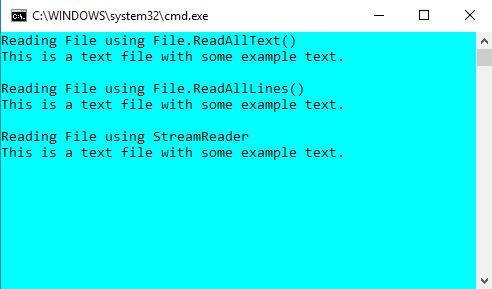La terminación de un programa conduce a la eliminación de todos los datos relacionados con él. Por lo tanto, necesitamos almacenar los datos en algún lugar. Los archivos se utilizan para almacenar y compartir datos de forma permanente. C# se puede utilizar para recuperar y manipular datos almacenados en archivos de texto.
Lectura de un archivo de texto: la clase de archivo en C# define dos métodos estáticos para leer un archivo de texto, a saber, File.ReadAllText() y File.ReadAllLines() .
- File.ReadAllText() lee todo el archivo a la vez y devuelve una string. Necesitamos almacenar esta string en una variable y usarla para mostrar el contenido en la pantalla.
- File.ReadAllLines() lee un archivo una línea a la vez y devuelve esa línea en formato de string. Necesitamos una array de strings para almacenar cada línea. Mostramos el contenido del archivo usando la misma array de strings.
Hay otra forma de leer un archivo y es mediante el uso de un objeto StreamReader. El StreamReader también lee una línea a la vez y devuelve una string. Todas las formas mencionadas anteriormente para leer un archivo se ilustran en el código de ejemplo que se proporciona a continuación.
// C# program to illustrate how
// to read a file in C#
using System;
using System.IO;
class Program {
static void Main(string[] args)
{
// Store the path of the textfile in your system
string file = @"M:\Documents\Textfile.txt";
Console.WriteLine("Reading File using File.ReadAllText()");
// To read the entire file at once
if (File.Exists(file)) {
// Read all the content in one string
// and display the string
string str = File.ReadAllText(file);
Console.WriteLine(str);
}
Console.WriteLine();
Console.WriteLine("Reading File using File.ReadAllLines()");
// To read a text file line by line
if (File.Exists(file)) {
// Store each line in array of strings
string[] lines = File.ReadAllLines(file);
foreach(string ln in lines)
Console.WriteLine(ln);
}
Console.WriteLine();
Console.WriteLine("Reading File using StreamReader");
// By using StreamReader
if (File.Exists(file)) {
// Reads file line by line
StreamReader Textfile = new StreamReader(file);
string line;
while ((line = Textfile.ReadLine()) != null) {
Console.WriteLine(line);
}
Textfile.Close();
Console.ReadKey();
}
Console.WriteLine();
}
}
Para ejecutar este programa, guarde el archivo con la extensión .cs y luego puede ejecutarlo usando el comando csc filename.cs en cmd. O puede usar Visual Studio . Aquí, tenemos un archivo de texto llamado Textfile.txt que tiene el contenido que se muestra en la salida.
Producción:

Escribir un archivo de texto: la clase File en C# define dos métodos estáticos para escribir un archivo de texto, a saber, File.WriteAllText() y File.WriteAllLines() .
- File.WriteAllText() escribe todo el archivo a la vez. Toma dos argumentos, la ruta del archivo y el texto que se tiene que escribir.
- File.WriteAllLines() escribe un archivo una línea a la vez. Toma dos argumentos, la ruta del archivo y el texto que debe escribirse, que es una array de strings.
Hay otra forma de escribir en un archivo y es mediante el uso de un objeto StreamWriter. El StreamWriter también escribe una línea a la vez. Los tres métodos de escritura crean un nuevo archivo si el archivo no existe, pero si el archivo ya está presente en esa ubicación especificada, se sobrescribe. Todas las formas mencionadas anteriormente de escribir en un archivo de texto se ilustran en el código de ejemplo que se proporciona a continuación.
// C# program to illustrate how
// to write a file in C#
using System;
using System.IO;
class Program {
static void Main(string[] args)
{
// Store the path of the textfile in your system
string file = @"M:\Documents\Textfile.txt";
// To write all of the text to the file
string text = "This is some text.";
File.WriteAllText(file, text);
// To display current contents of the file
Console.WriteLine(File.ReadAllText(file));
Console.WriteLine();
// To write text to file line by line
string[] textLines1 = { "This is the first line",
"This is the second line",
"This is the third line" };
File.WriteAllLines(file, textLines1);
// To display current contents of the file
Console.WriteLine(File.ReadAllText(file));
// To write to a file using StreamWriter
// Writes line by line
string[] textLines2 = { "This is the new first line",
"This is the new second line" };
using(StreamWriter writer = new StreamWriter(file))
{
foreach(string ln in textLines2)
{
writer.WriteLine(ln);
}
}
// To display current contents of the file
Console.WriteLine(File.ReadAllText(file));
Console.ReadKey();
}
}
Para ejecutar este programa, guarde el archivo con la extensión .cs y luego puede ejecutarlo usando el comando csc filename.cs en cmd. O puede usar Visual Studio .
Producción:

En caso de que desee agregar más texto a un archivo existente sin sobrescribir los datos ya almacenados en él, puede usar los métodos de adición proporcionados por la clase File de System.IO.
using System;
using System.IO;
class Program {
static void Main(string[] args)
{
// Store the path of the textfile in your system
string file = @"M:\Documents\Textfile.txt";
// To write all of the text to the file
string text1 = "This is some text.";
File.WriteAllText(file, text1);
// To append text to a file
string text2 = "This is text to be appended";
File.AppendAllText(file, text2);
// To display current contents of the file
Console.WriteLine(File.ReadAllText(file));
Console.ReadKey();
}
}
Producción:

Publicación traducida automáticamente
Artículo escrito por ManasiKirloskar y traducido por Barcelona Geeks. The original can be accessed here. Licence: CCBY-SA